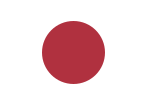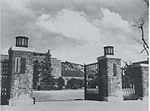bank issued the Korean yen from 1910 to 1945 and the won from 1945 to 1950. The bank was established by the Governor-General of Korea in 1910 as the Kankoku...
5 KB (584 words) - 05:35, 26 September 2024
Hanseatic City of Hamburg – Hamburger Bank (1619–1875) Korea under Japanese and American rule - Bank of Korea (1909–1950) Manchukuo – Central Bank of Manchou...
34 KB (419 words) - 20:47, 18 September 2024
institution in Korea under Japanese rule. It was formed in 1918 by merging six banks established under the Korean Empire. In 1950, it was renamed the Korea Industrial...
7 KB (741 words) - 16:26, 27 September 2024
Korea, the central bank of North Korea Bank of Korea (1909–1950), the central bank of Korea under Japanese rule, and of South Korea under American occupation...
337 bytes (85 words) - 18:03, 30 March 2011
Commercial Bank (조선상업은행, also transcribed as Joseon Sangup Bank), then in 1950 Korea Commercial Bank (한국상업은행). By the 1990s, Korea Commercial Bank was still...
9 KB (848 words) - 04:30, 28 September 2024
the turn of the century. These notes were redeemable in "Japanese Currency at any of its Branches in Korea". In 1909, the Bank of Korea (1909) (韓國銀行) was...
10 KB (514 words) - 08:49, 24 May 2024
Five Eulsa Traitors (category Articles containing Korean-language text)
Five Eulsa Traitors (Korean: 을사 오적) refers to the five officials serving under Emperor Gojong who signed the Japan–Korea Treaty of 1905, which is also...
4 KB (469 words) - 19:28, 28 March 2024
Kantō Massacre (redirect from Massacre of Koreans in 1923)
The Kantō Massacre (關東大虐殺, Korean: 간토 대학살) was a mass murder in the Kantō region of Japan committed in the aftermath of the 1923 Great Kantō earthquake...
44 KB (4,970 words) - 19:21, 19 September 2024
Most of Korea's infrastructure built during this time was destroyed during the 1950-1953 Korean War. These conditions led to the birth of the Korean independence...
186 KB (19,470 words) - 05:41, 3 October 2024
Governor-General of Chōsen (Japanese: 朝鮮総督, romanized: Chōsen Sōtoku; Korean: 조선총독, romanized: Joseon Chongdok) was the chief administrator of the Government-General...
8 KB (679 words) - 08:43, 25 August 2024
ethnic Korean permanent residents of Japan. The term Zainichi Korean refers only to long-term Korean residents of Japan who trace their roots to Korea under...
93 KB (10,239 words) - 21:40, 28 September 2024
Keijō (category Former prefectures of Japan in Korea)
Gyeongseong (Korean: 경성), was an administrative district of Korea under Japanese rule that corresponds to the present Seoul, the capital of South Korea. When...
7 KB (233 words) - 23:53, 29 September 2024
Gando Massacre (category CS1 Korean-language sources (ko))
committed by the Japanese military against the Korean residents of Gando (present-day Jiandao, Yanbian Korean Autonomous Prefecture, Jilin, China), after...
13 KB (1,416 words) - 15:39, 28 September 2024
Basic Relations Between Japan and the Republic of Korea (Japanese: 日韓基本条約 (Nikkan Kihon Jōyaku); Korean: 한일기본조약; Hanja: 韓日基本條約; RR: Hanil gibon joyak)...
17 KB (1,846 words) - 07:09, 14 September 2024
1945, ethnic Koreans worked with the Empire of Japan. Some of these figures contributed to or benefitted from Japan's colonization of Korea, and some actively...
18 KB (2,274 words) - 02:14, 19 August 2024
The Korean independence movement was a series of diplomatic and militant efforts to liberate Korea from Japanese rule. The movement began around the late...
28 KB (3,214 words) - 23:39, 28 August 2024
Hashima Island (category Japanese war crimes in Korea)
of the Sites of Japan's Meiji Industrial Revolution series. Japan and South Korea negotiated a deal to facilitate this, in which Korea would not object...
42 KB (4,291 words) - 06:25, 25 September 2024
Shinano River incident (category Japan–Korea relations)
Jiken) was the massacre of up to 100 Korean laborers in July 1922 who were working for the Okura zaibatsu at the construction site of a power plant on the...
4 KB (427 words) - 06:57, 16 February 2024
Iljinhoe (category Articles containing Korean-language text)
was a nationwide organization in Korea formed on August 8, 1904.[citation needed] A Japanese record states the number of party members was about 800,000...
3 KB (352 words) - 13:43, 2 September 2024
seat of the National Assembly of South Korea and housing offices of the Government of South Korea until 1950 when it was damaged during the Korean War...
14 KB (1,532 words) - 02:30, 15 June 2024
Japanese Korean Army (朝鮮軍, Chōsen-gun, lit. 'Korean military') was an army of the Imperial Japanese Army that formed a garrison force in Korea under Japanese...
10 KB (567 words) - 20:37, 25 April 2024
Comfort women (redirect from Serial Kidnapping of Women in Korea in 1930's)
Japanese troops forced hundreds of thousands of women from Australia, Burma, China, the Netherlands, the Philippines, Japan, Korea, Indonesia, East Timor, New...
252 KB (25,489 words) - 09:28, 4 October 2024
by the Bank of Chōsen. It continued to operate as a library until the 1945 liberation of Korea. Afterwards, it was succeeded by the South Korean National...
4 KB (278 words) - 10:41, 2 June 2024
Korea (Korean: 한국, romanized: Hanguk in South Korea, or 조선, Chosŏn in North Korea) is a peninsular region in East Asia consisting of the Korean Peninsula...
167 KB (15,381 words) - 22:58, 29 September 2024
Keijō Imperial University (redirect from University of Keijō)
(Seoul), Korea, Empire of Japan that existed between 1924 and 1946. The university was seen as the preeminent educational institution in colonial Korea. Upon...
17 KB (1,935 words) - 00:04, 12 July 2024
105-Man Incident (category 1911 in Korea)
result of several Korean attempts in 1910 to assassinate Terauchi Masatake, the Governor-General of Korea arrested over 700 Koreans, many of whom were...
4 KB (403 words) - 01:52, 8 November 2023
Heijō Shrine (category 1913 establishments in Korea)
during its occupation of Korea. The shrine's main annual festival was held on October 2. It was formerly a national shrine of the third rank (国幣小社, kokuhei-shōsha)...
4 KB (216 words) - 01:36, 6 March 2024
the yang at a rate of 1 won = 5 yang. In 1909, the Bank of Korea was founded in Seoul as a central bank and began issuing currency of modern type. The won...
20 KB (2,847 words) - 07:13, 30 July 2024
Sōshi-kaimei (category Use of the text parameter in Infobox Korean name)
which forbade Koreans to take up Japanese names. In 1909, the Korean Empire established a civil registration law, starting the creation of a modern family...
21 KB (2,162 words) - 14:12, 6 September 2024
Chōsen Shrine (category Shinto shrines in Korea)
Hepburn: Chōsen Jingū, Korean: 조선신궁; Hanja: 朝鮮神宮) was the most important Shinto shrine during the Japanese colonial period in Korea. It was built in 1925...
10 KB (852 words) - 01:26, 5 September 2024

























